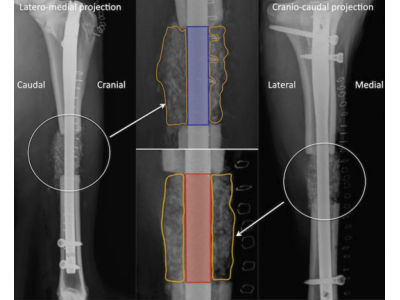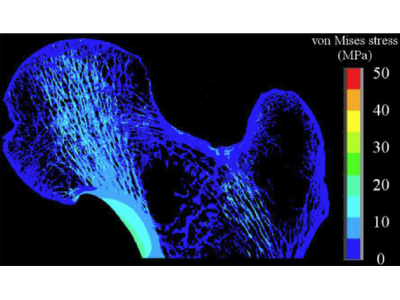Our software is enabling leading researchers to improve biomechanical simulations. Exagen Oy develop tailored tools that redefine the scale of volumetric data processing, and accelerate research.
We create new algorithms to accelerate research
When your workflows take days or weeks to process, we can help. Spend time where it counts, not fighting with your systems. We can remove bottle-necks with our custom solutions that integrate seamlessly with your existing work-flows. Get insights more quickly, and stay agile, even when processing Terabytes of data.
We have partnered with leading researchers providing a range of services including medical image analyses and data analysis.
Measuring Bone Healing
Biomaterials research requires repeatable measures that accurately quantify changes. Exagen's expertise includes developing new algorithms and high-performance software that have been used in recently published research. Our software includes fast (GPU-accelerated) radiological image processing systems that quantify tissue healing. Our engineers are proficient in C++ and high-performance-computing libraries like CUDA and OpenGL. Full details of the research work are in the article (below) that was featured on the cover of the scientific journal Veterinary Comparative Orthopaedic Traumatology.
Radiological Measures of Fracture Healing
J.R. Field and G.S. Ruthenbeck (Exagen Oy Director & Founder).
Abstract
The formulation of appropriate postoperative strategies, following fracture repair, currently involves an understanding of radiological and clinical outcome measures. This study has evaluated several modalities used to assess the progression of bone healing in a sheep tibial segmental defect model. ... The utilization of both qualitative and quantitative data, in assessment of the progression of fracture healing, has provided valuable insight. Measures of optical density have been shown to make a substantial contribution to this assessment and which should be considered for use in studies evaluating fracture healing.
This work was featured on the cover of the Journal of Veterinary and Comparative Orthopaedics, January 2018. Article full text (free) PDF (Research Gate).
Biomechanics at Ultra-High Resolution
Our software reduced processing times from hours to minutes, and increased the upper-limits of the biomechanics simulation by 10x - 100x. With better data processes, we have enabled world leading bio-mechanics researchers to simulate at higher-resolution than ever before. By improving simulation resolution and accuracy we are helping to develop better surgical implants and surgical devices.
FEM Micro-Structural Analysis of the Femur
S Martelli, E Perilli, GS Ruthenbeck (Exagen Oy Director & Founder), Y Bala, M Taylor, KJ Reynolds
Abstract
Understanding how the trabecular and cortical compartments contribute to the load-bearing capacity of the human proximal femur has important implications to both clinical practice and basic-science. Advances in computing power and computed-tomography (CT) scanners over the last two decades now makes it possible to run large-scale micro-structural finite element (FE) analysis of the femur, providing in-depth information on the trabecular and cortical bone mechanics.
However, current microstructural femur models require large supercomputing power, ad-hoc software and the common point-load simplification of the hip contact force that lead to numerical artefacts in the femoral head region. We present a novel software pipeline for generating micro-structural FE models of the human femur, determine the hip pressure distribution on the femoral head, solve the elastic problem and post-process the large result file.
Data can be simple... Even big data
We specialize in tailored to solutions to big data problems. Our deep research and software-engineering expertise have empowered leading researchers to redefine the scale of their work and answer the big questions. Please contact us to discuss the potential. We'd love to help you to do more with your data.

